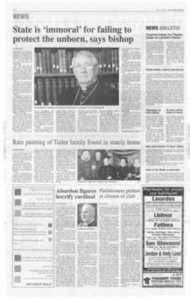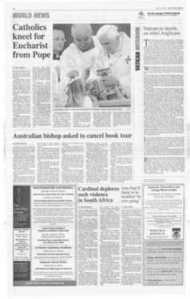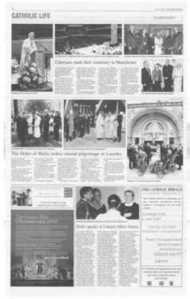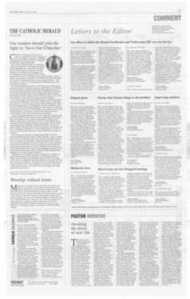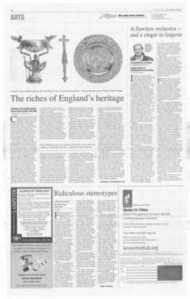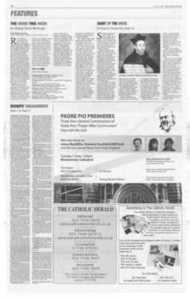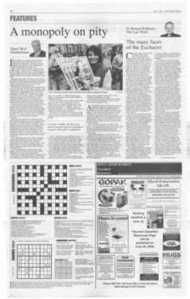Page 12, 30th May 2008
Page 12

Report an error
Noticed an error on this page?If you've noticed an error in this article please click here to report it.
Tags
Share
Related articles
A Glittering Testament To The Real Presence
Pamphlet Guides Catholics On Colour Problem
Goldsmith's Losses
Hail, Queen Of Heaven
The Magi Go West
The riches of England's heritage
Treasures of the English Church: Sacred Gold and Silver 800-2000
GOLDSMITHS' HALL. UNTIL. JULY 12
Church plate is among the most secret categories of silver and goldsmiths' work. Even today, with Mass celebrated facing the people and Holy Communion given in both species, most worshippers get only a glance at sacred vessels and, even then, few look closely because receiving the Blessed Sacrament transcends, or should transcend, idle curiosity. With the exception of priests, servers and sacristans, few have the opportunity of examining in detail the vessels used at the altar.
The mystery surrounding church plate is opened to view by an exhibition at Goldsmiths' Hall mounted by Timothy Schroder, Treasures of the English Church, which consists of a survey that starts in the ninth century and continues to the present time. Over the years there have been many exhibitions of church plate but so far none as comprehensive as this. It is not a scholarly exercise aimed at specialists (there is no catalogue, but there is an accompanying book of essays) but a populist presentation which will enable the general public to form an impression of the riches that lie hidden in English cathedrals, churches, and collegiate institutions. Quibblingly, I noticed that John Cosin, the 17th-century Bishop of Durham, is described as Bishop Cosens, and the designer of the Archbishop of Canterbury's primatial cross as Thomas Bodley (the founder of the Bodleian Library. Oxford), rather than George Frederick Bodley (the leading English late 19th-century church architect). But the splendour associated with their names gives an indication of the sumptuousness on display.
On entry the visitor is greeted by a show of recent altar plate for York Minster and Lichfield Cathedral; going further one enters the 20th century, starting with silver of the Arts and Crafts Movement, of which Omar Rarrisden's monstrance from Westminster Cathedral assumes a prominent place. and then proceeds through a selective survey of modem plate. This surprising opening was intended to make people question the origin and nature of church plate before embarking on a chronological survey upstairs. But much on display, however well-crafted, lowers the temperature a little before arriving at the splendour that is to come. Altar plate, like church architecture, symbolises not only the strength and weakness of different periods of religious history but also differing doctrinal emphases, and these become clearer once the medieval origins are reached.
A handsome start is made with the founders` plate from New College and Corpus Christi College, Oxford, including William of Wykeham's episcopal ring and regalia, and Bishop Fox's chalice and paten made c1507 and the earliest piece of hallmarked English gold in existence. The Church was the principal patron of plate in the Middle Ages and this is exemplified not merely by the fine silver parcel-gilt chalice, paten, pallium-pins and jewels belonging to • Hubert Walter, Archbishop of Canterbury from 1193-1205, but by a wide range of medieval plate. Engraved iconography is shown in a case of patens, a rare instance of making such a comparison.
The main body of plate is post-Reformation and reaches a climax in the magnificent 17th-century altar sets from St George's Chapel, Windsor, and the Cathedrals of Durham, Rochester and Christ Church, Oxford. These include much cast, heavily chased and embossed work in the form of flagons, alms dishes and candlesticks with fine profiles. The change from small chalice and cruet to capacious Communion cup and flagon represents a Protestant understanding of the Eucharist as a memorial meal rather than a sacrifice. It was not until the 17th century, under the sacramental reforms of Archbishop Laud, that Anglican church plate was given a richer character.
Secular plate was given to churches after the Reformation as it fell out of fashion and one of the strengths of the exhibition lies in the varied quantity of work from this source that would otherwise have been melted down and lost. St John Baptist's, Cirencester, has lent a cup said to have been given by Anne Boleyn to her daughter Princess Elizabeth, presented by her to Richard Masters, her physician, and given by him to his parish church. Of the surviv ing early 17th-century steeple cups, a third are in the possession of parish churches.
There is a rich section devoted to Catholic recusant plate. This includes silver from Arundel Castle, the Petre family plate from Thomden, in Essex, lent from Brentwood Cathedral, and a rare silver-gilt and rock-crystal reliquary, hallmarked in London in 1551, and made during the reign of Queen Mary I by Affabel Partridge, royal goldsmith to the Queen and Queen Elizabeth I. It was found in some abbey ruins and given to the Poor Clams in Rouen by Lady Browne of Kidington in 1737. The Victorian revival of church plate was initiated by Pugin and it is disappointing that so little of his best work is included. Instead we have virtuosic examples of heavily jewelled chalices designed by Burges and Butterfield from St Michael's, Brighton, and All Saints, Margaret Street. Technically Victorian church plate equalled. and sometimes exceeded, the workmanship of medieval plate.
Overall, this is an outstanding presentation of church silver that will not be seen together for a long time, if ever. Given the distinction of the work. I wish that more exact attention had been paid to individual items, and I have reservations about the theatrical exhibition—design. meant to assume an eccle, siastical atmosphere, which masks the noble rooms and overwhelms the exhibits. But this exhibition offers a rare opportunity to see matchless silver that will open people's eyes to the enigmatic cultural legacy of the English Christian tradition and establishes integral links with our Catholic birthright.
Anthony Symondson SJ
blog comments powered by Disqus



